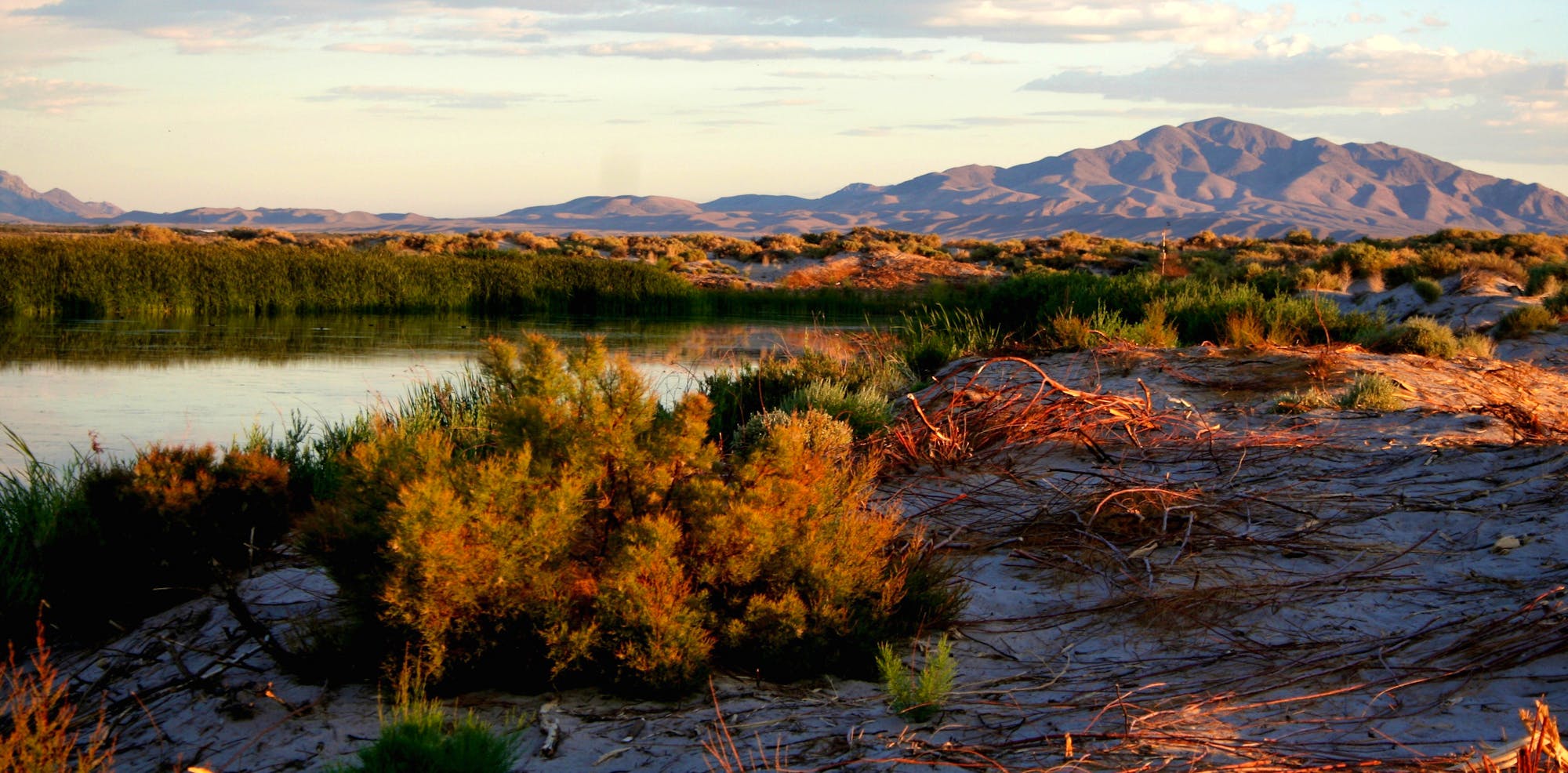The Past and Future of Ash Meadows National Wildlife Refuge
In southern Nevada, there is a fragile oasis in the driest desert in the U.S. Its spring-fed pools and streams allow life to flourish in an otherwise harsh environment and support a record number of species found nowhere else. Ash Meadows National Wildlife Refuge was created to protect this unique ecosystem from planned development that could have destroyed it. The life-giving waters of Ash Meadows still, however, face threats from mining activities outside the Refuge’s borders.
The Invisible River
Ash Meadows lies in the path of a mostly invisible river. From its headwaters to its outlet at Badwater Basin in Death Valley National Park, the Amargosa River flows 175 miles mostly underground. It is sometimes called the “Hide and Seek River” because it surfaces at only a few locations — including Ash Meadows — before disappearing again. The springs of Ash Meadows make it the largest remaining oasis in the Mojave Desert, the water for which is supplied by an aquifer that was filled during the last ice age. Indigenous people have lived along the Amargosa River’s course since that time, including the Southern Paiute (Nuwuvi) and Timbisha Shoshone (Newe) Tribes for the past several thousand years.
A History of Exploitation
Before Ash Meadows became a refuge, its environment was damaged by human activities. Peat harvest destroyed 2,000 acres of wetland habitat. Cattle were brought in and streams were diverted into concrete channels and reservoirs. The pumping of groundwater to maintain the cattle caused water levels in the springs to drop. Non-native species like crayfish and bullfrogs were introduced. Some combination of these factors caused the extinction of at least one species, the Ash Meadows killifish. A 20,000-lot resort community proposed for the area would likely have resulted in more lost species, but this threat prompted the U.S. Fish and Wildlife Service, working with The Nature Conservancy, to acquire the property and add it to the National Wildlife Refuge System.
Saving the Wildlife of Ash Meadows
Ash Meadows National Wildlife Refuge was established in 1984 under the authority of the Endangered Species Act. Its purpose was also derived from the ESA: “...to conserve…fish or wildlife which are listed as endangered species or threatened species...” Ash Meadow’s springs have created a hotspot of biodiversity, containing at least 26 endemic species, meaning they do not occur anywhere else on Earth. This is more than any other refuge or any area of similar size in the U.S.
Of the endemic species, four fish are listed as endangered and eight plants are listed as endangered or threatened. One of the endangered fish is the Ash Meadows Amargosa pupfish. This plump, silvery fish grows no more than three inches long and feeds on algae and small invertebrates. Pupfish were named after the movements of territorial males, which reminded some of the playful behavior of a puppy. Most of the spring systems in the refuge are designated as critical habitat for this species.
The riparian vegetation growing near the springs also supports migratory birds like the endangered least Bell’s vireo and southwestern willow flycatcher.
A Threat in the Form of a Lithium Mine
As a refuge, Ash Meadows is protected from uses that would undermine its purpose of conserving listed species and their habitats. However, the reliance of those habitats on an underground river that crosses refuge boundaries leaves them vulnerable to activities outside the refuge. The refuge is surrounded by land managed by the Bureau of Land Management and an 1872 law makes this land available to mining.
In early 2023, a mining company submitted a notice to BLM that it would conduct exploratory drilling for lithium just north of the refuge. Some of their proposed boreholes were only a few hundred feet from the refuge’s boundary. This area was upstream of Ash Meadows in the path of the groundwater flow. The mining company acknowledged the boreholes would likely encounter groundwater, raising the possibility they could interfere with the supply of water to Ash Meadows. A feature not far from the refuge known as Borehole Springs was created by similar drilling that caused an unstoppable groundwater leak. If a leak like that happened in this case, it could have depleted the springs’ water at Ash Meadows and gravely threaten the species depending on them.
Defenders of Wildlife joined with coalition partners to oppose the proposed mine. Thankfully, the mining company abandoned the project in August 2025, likely due to pressure from the coalition and local communities.
Hope for Ash Meadows and Concern for the Future
To protect Ash Meadows from similar threats in the future, the coalition sought a mineral withdrawal to close BLM lands surrounding the refuge to any new mining claims. BLM initiated the proposed withdrawal in response to our advocacy, offering the Refuge a measure of protection for at least a two-year segregation period. The withdrawal remains in effect, unlike some others the Trump administration rescinded. However, there is no guarantee it will be finalized before the segregation expires. Even if it is, new or expanded mining operations may occur in parts of the withdrawal area subject to valid existing claims. Continued support from organizations like Defenders, and from the public, will be essential to ensure that Ash Meadows receives the protection it needs.
Ash Meadows is too sensitive and unique to put at risk. The refuge is more than lines on a map; its underground river connects the refuge to the landscape beyond. We must not ignore threats to the water just because it is hidden from view.
Learn more about the unique history and species of Ash Meadows in this storymap.
This blog was updated from a December 2023 story to include important victories for the campaign to protect Ash Meadows.





